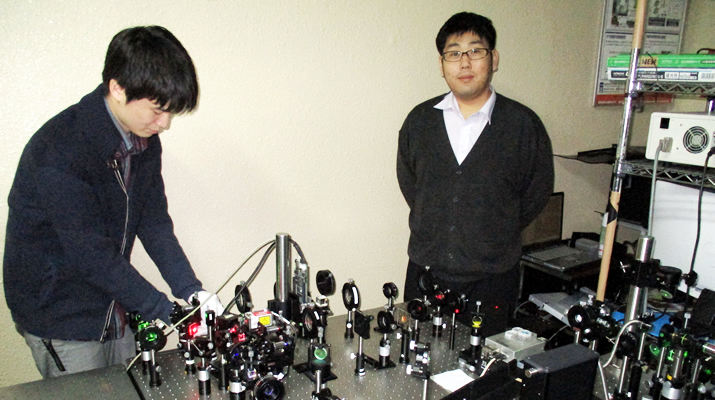
ここからコンテンツです。

Nano-magnets produce three-dimensional images
Wide-view three-dimensional holographic display composed of nano-magnetic pixelsBy Hiroyuki Takagi
Hiroyuki Takagi and his colleagues have developed a wide-view three- dimensional (3D) holographic display composed of nano-magnetic pixels. This 3D display, with 1-μm-pitch pixels, can show holographic images over viewing angles of 30 degree. This display is an attractive option for visualizing 3D objects with a smooth motion parallax and without using special glasses.
Conventional 3D displays, such as stereo displays with glasses and glass-free autostereoscopic displays, show two-dimensional images for each eye. Therefore, users experience incongruity and eyestrain because actual 3D images are not shown. A holographic display produces an exact copy of the wave front of scattered light from an object, and hence, a realistic 3D display is expected. Holographic displays can reconstruct realistic 3D images, thereby eliminating the need for special glasses.
However, construction of holographic displays is difficult, as nano-sized pixels are required for reconstructing 3D images with a wide viewing-angle. Conventional holographic displays have a viewing angle of <3 degree. In addition, conventional displays have a pixel pitch of 10–100 μm.
Associate Professor Takagi and his research team have recently developed wide-viewing 3D holographic displays composed of nano-magnetic pixels.

These displays are driven by thermomagnetic recordings, and wide viewing-angles are achieved through the use of in-house-developed magneto-optic spatial light modulators (MOSLMs) composed of nano-sized pixels.
According to Associate Professor Takagi, “The advantages of this approach are that the focused spot of a laser defines the pixel size, the MOSLM does not require special current or voltage drivelines, and the switching speed is about 10 nsec/pixel , which is enough for real-time display. Therefore, the MOSLM can represent 3D movies because the display media is made of a rewritable magnetic material. In addition, the magnetic hologram is stored for magnetic materials semi permanently. The viewing angle depends on pixel pitch size. In this study, we adjusted to the pixel pitch size of 1 μm after obtaining the pixel size of 1 μm.”
This confirms, as previously stated, that a 3D display with 1-μm-pitch pixels can display holographic images over viewing angles of 30 degree. Therefore, this display constitutes an attractive option for visualizing 3D objects with a smooth motion parallax and without special glasses.
This study was supported by
- JSPS KAKENHI Grant Numbers 26220902, 25820124, 15J05710 and 26706009
- SCOPE, 152106003
- JST PRESTO
Reference
K. Nakamura, H. Takagi, T. Goto, P. B. Lim, H. Horimai, H. Yoshikawa, V. M. Bove and M. Inoue, “Improvement of diffraction efficiency of three-dimensional magneto-optic spatial light modulator with magnetophotonic crystal”, Appl. Phys. Lett., 108, 022404 (2016).
ナノ磁石から3次元像
ナノ磁石で形成した広視野角3次元ディスプレイ高木宏幸准教授と研究グループは、ナノ磁石で構成された広視野角の3次元ディスプレイを開発した。画素サイズが1μmであり、視野角が30度以上の3次元像を再生できる。このディスプレイは特別なメガネが不要で視野角内の任意の角度、場所から3次元像を見る事が出来る。
自然な3次元(3D)像の表示技術は医療、教育、放送など幅広い分野において需要があり、応用が期待されている。従来のディスプレイはメガネが必要であったり、見る位置や角度が固定されていた。これらは2次元(2D)イメージによるもので、眼精疲労を生じる課題があった。ホログラフィーは実際の物体と同一の波面状態を持つ光を再現できるため、裸眼で3次元像を見ることができ、かつ輻輳と焦点の不一致による眼精疲労が生じないといった特徴を有している。
ホログラフィーにおいて3次元像を再生できる角度の最大値は視野角と呼ばれ、記録されたホログラムのピクセルサイズに依存している。これまで極めて多くのナノスケールの画素を有するディスプレイが開発することが困難で、また視野角は数度と限られていた。
今回開発されたディスプレイは、高密度および高速記録に優れる磁性体と熱磁気記録方式を用いる事で、ナノスケールの画素を有し、広視野角の3D像の再生を可能とした。
高木宏幸准教授によれば、「磁性体の磁化を制御するレーザ径によって、画素サイズをナノからマイクロメータまで制御することが可能である。磁性体の磁化のスイッチング速度は10nsec/pixelであり、ディスプレイ表示には十分である。今回はこの方法によって1 μmの磁気の画素を形成することが出来た。」
今回の3Dディスプレイは1 μm-pitchの画素を持つため、30度の広視野角を持つ3D像を再生することが出来る。今後、このディスプレイにより特別なメガネが不要で、視野角内の任意の位置から見る事ができる3Dディスプレイの開発が可能となる。
本研究は、JSPS科研費(26220902, 25820124,15J05710, 26706009)とSCOPE(152106003)、JSTさきがけの助成を受けて行われました。
Researcher Profile

| Name | Hiroyuki Takagi |
|---|---|
| Affiliation | Department of Electrical and Electronic Information Engineering |
| Title | Associate Professor |
| Fields of Research | Magnetics |
ここでコンテンツ終わりです。
